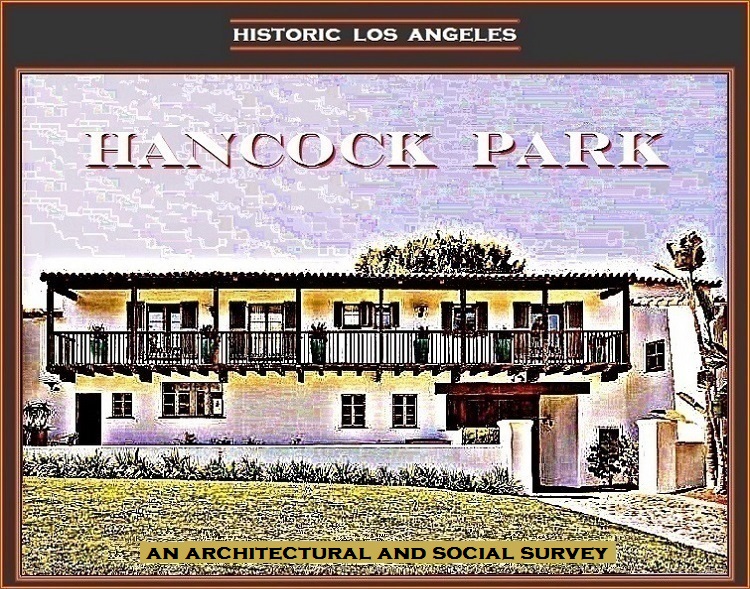PLEASE SEE OUR COMPANION HISTORIES
AN INTRODUCTION TO HANCOCK PARK IS HERE
400 South Hudson Avenue
- Built in 1924 on Lot 199 in Tract 6388
- Original commissioner: Isabella Rintoul Knapp
- Architect: Witmer & Watson (David J. Witmer and Loyall F. Watson)
- On April 26, 1924, the Department of Buildings issued Mrs. J. B. Knapp permits for a two-story, 16-room residence and a two-story, 15-by-28-foot garage at 400 South Hudson Avenue
- Isabella Rintoul Knapp was the widow of John Beach Knapp, a New York physician who died in 1916; moving from a Manhattan brownstone at 35 West 75th Street, Mrs. Knapp and three of her six children were by the next year renting a house across the country in Altadena. By 1922 she had decided to live in Los Angeles, renting 425 South Windsor Boulevard in Windsor Square, where she remained until the completion of 400 South Hudson Avenue
- By early 1932, Isabella Knapp had left 400 South Hudson Avenue with her only remaining child at home, Edith—who was not quite 40—moving to 300 St. Pierre Road in Bel-Air. Mrs. Knapp died in that house at the age of 87 on October 27, 1940. In 1948 Edith, having hired no less of an architect than Roland E. Coate to design a new eight-room house, moved into 355 North Rockingham Road in Brentwood, which a later owner would demolish and in 1985 replace with a house of, shall we say, less distinction than anything Coate might have designed. (The lot is across the street from another replaced residence, one that had been the home of the infamous O. J. Simpson at the time of his wife's murder.) Edith Knapp died one day shy of her 90th birthday on July 30, 1958. One of her two older sisters, Gertrude, had married mechanical engineer Lewis Adams Riley in May 1911; in 1937 their son Lewis Jr. married Rosamond Rosenbaum, who would become the well-known arts journalist and lecturer Rosamond Bernier, and then, having become a Hollywood producer and off-screen swordsman, Dolores del Río in 1959
- Mrs. Knapp appears to have sold 400 South Hudson, or rented it briefly, to Dr. and Mrs. Allen Sherman Martineau. On July 29, 1933, while the Martineaus were living at 400, the 36-year-old Martineau, who was a referred to in the press as a "fashionable Los Angeles physician," shot and killed himself at the Park Manor Hotel in San Diego while a rest trip with his wife, their two very young sons apparently having been left at home. His hometown Salt Lake Tribune reported only that Dr. Martineau died suddenly following a nervous attack. Lucile Martineau left 400 South Hudson soon after, with another physician succeeding her
- Dr. George Martyn and his wife, née Eva Cuvillier, bought 400 South Hudson in 1934. The English-born Martyn had at one time lived at 24 St. James Park, and prior to that at 38 St. James Park, apparently with a previous wife, and, having come to California in the 1900s, had by 1911 opened the Martyn Sanitarium in Pasadena for the treatment of tuberculosis. The Martyns were frequently mentioned in social columns during their time at 400; it is unclear as to when Dr. Martyn died, but his widow retained possession of the property until at least 1956. Having moved to a small house in Beverly Hills, she died in July 1958
- Settling into 400 South Hudson by early 1957 for a near 50-year stay was William Stinehart Sr. and his wife Martha and their two children, who were moving from a house built by his father in 1940 at 424 North Highland Avenue on the west edge of Hancock Park. William Stinehart was an attorney and executive with the Carnation Company, which had opened its iconic (and now lost) Miracle Mile headquarters building in August 1949
- On March 19, 1957, Mrs. William Stinehart was issued a permit by the Department of Building and Safety for the enclosure of a porch at 400 South Hudson Avenue. On July 23, 1962, William Stinehart was issued a permit for a 16-by-36-foot swimming pool. On April 17, 1973, Stinehart was issued a permit for a new 22-by-35-foot garage and storage building at the rear of the property
- After the departure of the Stinehart family in 2005 a new owner carried out a number of remodelings including a small rear northside addition, an apparent replacement of the 1962 pool, and the demolition and replacement of the 1973 garage and storage building
Illustration: Private Collection

